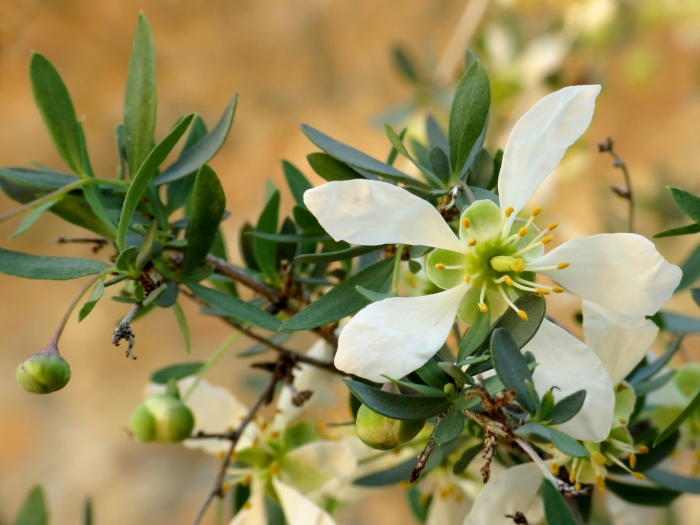Ragged Rockflower
(Crossosoma bigelovii)
Ragged Rockflower (Crossosoma bigelovii)
/
/

Katja Schulz
CC BY 4.0
Image By:
Katja Schulz
Recorded By:
Copyright:
CC BY 4.0
Copyright Notice:
Photo by: Katja Schulz | License Type: CC BY 4.0 | License URL: http://creativecommons.org/licenses/by/4.0/ | Rights Holder: Katja Schulz | Publisher: iNaturalist | Date Created: 2016-02-24T15:58:32-08:00 |

















































Estimated Native Range
Summary
Crossosoma bigelovii, commonly known as Ragged Rockflower, is a deciduous shrub native to rocky slopes, canyons, and desert scrublands in the Southwestern United States and Northwestern Mexico. It typically grows to a height of 1–2 meters (3.3–6.6 ft). The plant is characterized by its intricate, thorn-tipped branches and clusters of small, deciduous, gray-green leaves that are no longer than 1.5 centimeters. During its flowering season, which occurs in the spring, Ragged Rockflower produces a striking display of flowers. Each inflorescence bears a single flower with five white to purple-tinged petals, each about a centimeter long and narrowing to claws at their bases. The flowers are modest in size but can add a delicate beauty to the landscape.
Ragged Rockflower is valued for its unique appearance and adaptability to arid environments, making it suitable for habitat gardens and natural landscaping, particularly in desert butterfly gardens. It requires minimal maintenance once established, but gardeners should be cautious not to over-water, as this can be fatal to the plant. In cultivation, it thrives in full sun or part shade and prefers well-drained soils. While it can be grown from seed, it is not commonly found in nurseries and may be challenging for the average homeowner to cultivate due to its specific water and soil requirements.CC BY-SA 4.0
Ragged Rockflower is valued for its unique appearance and adaptability to arid environments, making it suitable for habitat gardens and natural landscaping, particularly in desert butterfly gardens. It requires minimal maintenance once established, but gardeners should be cautious not to over-water, as this can be fatal to the plant. In cultivation, it thrives in full sun or part shade and prefers well-drained soils. While it can be grown from seed, it is not commonly found in nurseries and may be challenging for the average homeowner to cultivate due to its specific water and soil requirements.CC BY-SA 4.0
Plant Description
- Plant Type: Shrub
- Height: 3-6 feet
- Width: 3-6 feet
- Growth Rate: Moderate
- Flower Color: White
- Flowering Season: Winter, Spring
- Leaf Retention: Deciduous
Growth Requirements
- Sun: Full Sun, Part Shade
- Water: Low, Medium
- Drainage: Medium
Common Uses
Bird Garden, Butterfly Garden, Low Maintenance, Potted Plant, Rock Garden, Showy Flowers
Natural Habitat
Native to rocky slopes, canyons, and desert scrublands in the Southwestern United States and Northwestern Mexico
Other Names
Common Names: Bigelow’s Crossosoma, Ragged Rock Flower, Rhyolite Bush
Scientific Names: , Crossosoma bigelovii, Crossosoma parviflorum, Crossosoma bigelovii var. glaucum, Crossosoma glaucum, Crossosoma bigelovii var. bigelovii, Crossosoma bigelovii subsp. glaucum, Crossosoma bigelovii var. parviflora, Crossosoma bigelowii var. glaucum, Crossosoma bigelowii var. parviflorum,
GBIF Accepted Name: Crossosoma bigelovii S.Watson